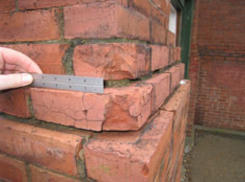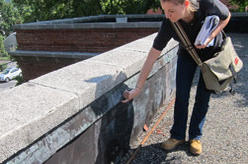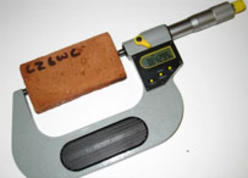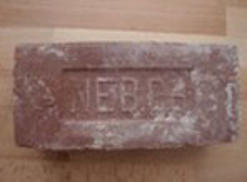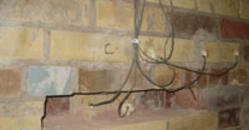Masonry walls are generally highly durable. However, when masonry walls are too wet during freezing spells, freeze-thaw damage can occur. This issue has particular relevance for energy efficiency retrofits: interior insulation makes masonry colder in winter, lowering its ability to dry and increasing the penetration of freezing temperatures. It is critical to prevent such damage, especially in historic buildings – at the same time, a huge opportunity for energy savings is lost if retrofits are unnecessarily avoided because of ultra-conservative, unfounded, and/or misguided risk assessment approaches.
For a number of years, Building Science Corporation has been continuously developing and refining tools for assessing these risks. Our goal is for all masonry buildings considering thermal insulation upgrades to have access to accurate risk assessments at a reasonable cost.
Approach
BSC’s research into freeze-thaw damage has drawn strongly on our field experience, which in turn is informed by research findings. This cyclical and incremental approach has led to the following risk assessment process, which we continue to refine.
Risk Assessment Steps
BSC recommends and uses the following set of steps when assessing the risk of freeze-thaw damage for a potential retrofit. Each step has its own costs and benefits; the selected combination of tools should be optimized based on the particular situation.
- Site Visit. Inspection by a building scientist is usually the best first step. A good inspection may make further steps unnecessary: buildings that are very high risk or very low risk can often be identified in the field. Inspection may also find existing problems (such as rising damp, air leakage, etc.) that must be addressed before insulating. Fixing a leaking downspout is more important than any further testing and analysis.
- Material Testing. When a field visit does not provide enough data for decision-making, the next step is materials testing and hygrothermal modeling (WUFI). BSC uses standard material testing along with frost dilatometry techniques developed in our labs to quantify freeze-thaw resistance. The results from these tests, together with conservative estimates of exposure to the elements, are then used in WUFI modeling to evaluate risk.
- Site Load Assessment. If more data about the environmental conditions of the building site are needed to reduce uncertainty, a site load assessment is the next step. Data is gathered about local weather conditions and rain deposited on walls. This data is used to update the WUFI model and refine the risk prediction.
- Prototype Monitoring. For historically significant buildings, where a very high degree of certainty is needed, a small area of the building may be insulated and closely monitored to provide additional real-world data. This data is used to confirm the accuracy of the WUFI model, and may lead to further refinement.
- Retrofit and/or Repair. Once enough data is gathered to make a decision, action is taken by the project team – either to prepare the building for adding insulation (for example, fixing leaky walls), and/or to complete the retrofit with insulation, or to exclude insulation from retrofit plans.
- Maintain and Monitor. Masonry that is insulated is more vulnerable, and changing site conditions or deterioration of rainwater management elements (such as drainpipes or flashing) can cause unexpected problems. A program of continuous inspection, as well as repair of any damage, is a prudent step.
Note that this framework treats hygrothermal modeling as an important — but not always essential — component of risk assessment. Its use should be carefully considered in combination with other assessment tools. A more detailed overview of each step can be found at Freeze-Thaw Risk Assessment Steps.
Research Areas
Improving risk assessment practices requires advancing knowledge of freeze-thaw damage. We need to know what factors predict damage and how to measure those factors in a practical, cost-effective, and reliable way. BSC is contributing to this knowledge in several areas.
Masonry testing (frost dilatometry). In the past, two pass/fail tests have been used to assess the freeze-thaw “resistance” of masonry: the cold water/boiling water absorption ratio (c/b ratio), and the 50-cycle freeze-thaw test. However, these approaches do not adequately represent the freezing mechanisms or conditions that masonry experience in the field. Frost dilatometry, first proposed by Fagerlund in the 1970s, is an alternative approach that BSC is using and developing for commercial application. Our research has focused on the use of Scrit (the critical degree of saturation) in risk assessments, and on improving the cost-effectiveness and reliability of testing.
Site load assessment. When considering moisture loads on masonry walls, driving rain is far more important than any other source of moisture in almost all building types and climates. Despite the importance of driving rain to building performance, relatively little is known about the magnitude, duration, and frequency of driving rain and driving rain deposition on buildings. BSC is beginning investigations to add to existing knowledge in this area
Risk to embedded wood and steel. Steel and wood members embedded in masonry walls may be damaged by moisture after walls are insulated on the interior. BSC’s recent research in this area has focused on understanding the mechanisms affecting embedded wood members and the effectiveness of mitigation measures.
Effects of salts. Although freeze-thaw degradation is accepted as the major cause of masonry deterioration in cold climates, salts are likely the second most important cause. Furthermore, significant concentrations of salts affect how moisture moves through masonry, which in turn may worsen freeze-thaw degradation. Measures to evaluate signs of salt damage are available, but often it is difficult to diagnose with certainty. BSC is developing inexpensive salt content measurements and investigating impacts on moisture transfer.
Sensor development. Unfortunately, there is no well-established, non-destructive measurement technique which accurately quantifies the moisture content through the depth of a masonry wall, and in the full range of moisture contents that are linked with freeze-thaw damage. Hygrothermal simulation tools have been calibrated using core samples, which is not a feasible approach for most projects. Wood “plug” sensors (relative humidity surrogates) are also currently used (embedded in walls) to provide an indication of wetness. BSC is constantly refining, improving, and evaluating alternatives to these sensors.
Who is Involved
BSC’s research has developed over the course of multiple projects. Some significant partners and collaborators include the following.
- The Building Engineering Group at the University of Waterloo was instrumental in developing the frost dilatometry approach for our testing of masonry. See "Determining the Critical Degree of Saturation of Brick Using Frost Dilatometry" by Peter Mensinga.
- Halsall Engineering was an early adopter of frost dilatometry and has collaborated with BSC on a number of conference papers sharing findings on the approach.
What We Have Learned/Demonstrated
To date, research has yielded a number of important findings.
Exterior insulation is preferred, but interior insulation can be added safely. Although exterior insulation is the safest option for masonry walls, interior insulation can be successful when risk is carefully assessed and minimized.
Different situations require different assessments. At each stage, the available data should be considered to determine whether it is adequate for decision-making. Assessment tools should only be used where they add value.
Frost dilatometry is a viable risk assessment approach. BSC’s work has shown that frost dilatometry can, using a relatively fast and simple test protocol, provide the critical degree of saturation for a given masonry material. Informed design decisions can then be made by comparing predicted moisture loads during freezing to measured Scrit levels. This finding is important because current ASTM tests used in industry (ASTM C62 and C67, and the cold soak/boil or c/b ratio) are not reliable determinants of freeze thaw risks, resulting in both false positives and false negatives1.
There is currently no shortcut for Scrit. It would be ideal if the Scrit level for a given material could be estimated based on more easily obtained information, such as manufacturer, manufacturing method (pressed vs. extruded brick), vintage, density, porosity, etc. Using data from 24 past projects, BSC has found that strong connections between these data points are not apparent. A larger data set may allow useful patterns to emerge.
Retrofitting masonry may also affect embedded members. Our forensic observations have reinforced the connection between masonry moisture content and corrosion of embedded steel members. Our measurements of buildings show higher masonry moisture contents after retrofit; it is reasonable to expect an increased risk of embedded steel corrosion. As well, in-situ monitoring of embedded wood joists found that many of the joists show high moisture contents, with some continuously in the 20-30% MC range. Orientation was an important factor: the highest moisture contents were found on the north side and on the sun-sheltered east side. This research is ongoing.
Insulating masonry buildings is important so that they can be kept comfortable at a reasonable energy cost. Providing better options for addressing associated risks is a priority for BSC – all building owners should have a feasible opportunity to insulate their buildings. We envision moving the industry toward better risk assessment methods while working with design teams and product manufacturers to develop and promote better approaches.
1Butterworth, B. and L.W. Baldwin. 1964. Laboratory test and the durability of brick: The indirect appraisal of durability (continued). Transactions of the British Ceramics Society 63(11):647–61; Litvan, G. 1975. Testing the frost susceptibility of bricks. In Masonry: Past and Present, pp. 123-132. ASTM STP 589.

